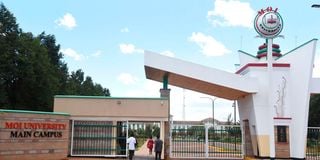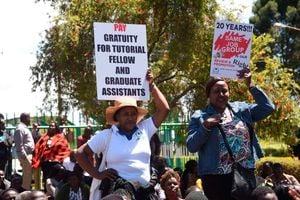
The entrance to Moi University's main campus in Kesses, Uasin Gishu County on February 8, 2024.
What is happening to Moi University? The answers are numerous and vary with interlocutors. It seems unable to meet any of its basic obligations: teaching and research, paying salaries and remitting payroll deductions.
Teaching and non-teaching staff have waged industrial action, and students have staged demonstrations.
The police shot at students, grievously wounding at least one of them.
The university has been closed and reopened. Concern has been raised from the villages to Parliament. And so on, and so forth.
Another strain of discourse will recite a damning assortment of delicts, from malpractice and misconduct and negligence.
The accepted modus operandi for this strain of discourse is to either abridge this litany or stack it in that versatile normative aggregate, corruption, whose definition has tended to vary as broadly as the spectrum of analysts and commentators having a tilt at the vexed subject, and the diversity of acts and omissions said to constitute it.
However, in terms of explicating chronic organisational dysfunction, corruption as a heuristic is simply magical.
The species of corruption addling Moi University is not altogether novel, but it has been asserted that the iteration on display is its most distilled expression insofar as it is catalysed by toxic atavism at the ethno-regional domain.
It is a most tragic and shameful fact of life that the world over, ethnic representation in institutions of higher education has historically been anything but equitable.
In Kenya, studies have established egregious divergence between rates of access to higher education and national demographic profiles, as well as in the composition of management and leadership of various campuses.
As platforms for elite conditioning, universities are possibly society's last chance to self-consciously model an ideal vision of itself in the working understandings of its nascent leadership.
At this level, the values imparted in word and deed matter beyond their very real effects on the immediate experiences of implicated individuals.
I worry about the long-term impact of our national practice of accommodating young learners in facilities that frightfully mimic prison cells in secondary school, and squalid slums in the university; what right have we to expect sound leadership or basic decency, let alone soaring idealism and aspirational aesthetic, from people whose formative years were defined by a keen survival imperative under a policy of official neglect and abuse?
Be that as it may, it may be worthwhile to investigate whether Moi University stands out as a uniquely delinquent or, if you will, an outlier in terms of vulnerability to catastrophic dysfunction.
On the positive side, the university went out of its way to have a diverse Council, Senate and faculty leadership for the first three decades of its existence.
Needless to say, the student body was exemplary in its diversity, and if its leadership seemed to favour men of a particular regional extraction, this was more to do with exceptionally keen political awareness by dint of broader off-campus dynamics, which afforded them apprenticeships or, at least, a model for effective mobilisation.
The first vice-chancellors of local extraction were appointed recently, and this development was poorly received outside the university's immediate locality.
Considering the 2007 crisis in the light of local responses to what was perceived to be Narc's vengeful onslaught on local elites, ethnicity has become a salient variable and silent powder keg.
On one hand, local ethno-regional extremists have discovered a diabolical means of deploying threats of violent upheaval in furtherance of political strategies.
On the other hand, equally radicalised adversaries have innovated the subtle weaponisation of 2007 and a stylised rendering of ‘tribalism' to push extremists back. In the middle ground, everybody else is bewildered and miserable.
It is now a local tradition that the appointment of an ‘indigenous’ vice-chancellor is accompanied by extreme reactions and outright opposition, which tends to suggest in the eyes of locals that their kith and kin are deemed inherently ineligible, with the unwholesome implication that they can only rise to these positions by way of shady modes of patronage.
The insidious schemes and machinations deployed by opposing factions, each convinced that its survival depends on preventing the other from acquiring control, guarantee a most insalubrious organisational climate.
In nearly every region, leaders are perennially occupied in the Sisyphean drudgery of resuscitating the ruins of failed public concerns that fell to the voracious predations of ethno-regional patronage.
Others are rescued periodically at the public's expense, yet relapse immediately following the dispensation of the fisc.
The new constitutional dispensation did not devolve bad manners.
On the contrary, insatiable impulses lay in wait at the ethno-regional heartlands, having been repulsed from the national capital- the nucleus and apex of our political economy- during the implementation of an Africanisation policy which, in effect, exclusively lavished an ethno-regional network closely associated with the first president.
Dejected, but no less ravenous, these marginalised appetites descended upon all resources within reach with mighty vengeance, and in the process, precedents were established.
In one way or other, all these dynamics are at play in Moi University.
The writer is an Advocate of the High Court of Kenya






